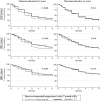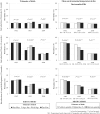Seasonality of infant feeding practices in three Brazilian birth cohorts
- PMID: 22354916
- PMCID: PMC3396312
- DOI: 10.1093/ije/dys002
Seasonality of infant feeding practices in three Brazilian birth cohorts
Abstract
Background: We assessed the influence of season of birth on duration of breastfeeding and other feeding patterns in three population-based birth cohort studies in the city of Pelotas, Southern Brazil.
Methods: In 1982, 1993 and 2004, all hospital-born children in the city were enrolled in three cohort studies (n = 5914, 5249 and 4287, respectively). Children and their mothers were periodically visited in the first 2 years of life, to collect information on the duration of breastfeeding and the ages at which different types of foods were introduced on a regular basis. Two independent variables were studied: month of birth and mean environmental temperature in the first month of life. Survival analyses and chi-squared tests were used to evaluate the associations. Temperature-based slope indices of inequality were also calculated.
Results: Duration of breastfeeding was lower among children born from April to June (months preceding winter) and spending their first month of life in colder temperatures. The influence of season of birth on breastfeeding patterns and the introduction of cow's milk differed according to maternal education, with the strongest effects among children belonging to less educated mothers. Early introduction of fruits (1982 and 1993 cohorts) and vegetables (1982 cohort) were also associated with lower environmental temperature in the first month of life, but not with trimester of birth.
Conclusion: Colder temperatures adversely affect duration of breastfeeding and feeding patterns in infancy, especially among the poorest. This finding should be considered in breastfeeding promotion programmes.
Figures


Similar articles
-
First- and second-trimester WIC participation is associated with lower rates of breastfeeding and early introduction of cow's milk during infancy.J Am Diet Assoc. 2010 May;110(5):702-9. doi: 10.1016/j.jada.2010.02.013. J Am Diet Assoc. 2010. PMID: 20430131
-
Factors influencing milk insufficiency and its long-term health effects: the Bedouin Infant Feeding Study.Int J Epidemiol. 1992 Feb;21(1):53-8. doi: 10.1093/ije/21.1.53. Int J Epidemiol. 1992. PMID: 1544758
-
Breastfeeding exclusivity and duration: trends and inequalities in four population-based birth cohorts in Pelotas, Brazil, 1982-2015.Int J Epidemiol. 2019 Apr 1;48(Suppl 1):i72-i79. doi: 10.1093/ije/dyy159. Int J Epidemiol. 2019. PMID: 30883659 Free PMC article.
-
Breastfeeding promotion and priority setting in health.Health Policy Plan. 1996 Jun;11(2):156-68. doi: 10.1093/heapol/11.2.156. Health Policy Plan. 1996. PMID: 10158457 Review.
-
Role of breast-feeding in the prevention and treatment of diarrhoea.J Diarrhoeal Dis Res. 1990 Sep;8(3):68-81. J Diarrhoeal Dis Res. 1990. PMID: 2243179 Review.
Cited by
-
Integrating Traditional Nutritional Wisdom into Digital Nutrition Platforms: Toward Culturally Adaptive and Inclusive Health Technologies.Nutrients. 2025 Jun 11;17(12):1978. doi: 10.3390/nu17121978. Nutrients. 2025. PMID: 40573089 Free PMC article.
-
Breastfeeding and bone mass at the ages of 18 and 30: prospective analysis of live births from the Pelotas (Brazil) 1982 and 1993 cohorts.PLoS One. 2015 Apr 16;10(4):e0122759. doi: 10.1371/journal.pone.0122759. eCollection 2015. PLoS One. 2015. PMID: 25880483 Free PMC article.
-
Effects of Birth Month on Child Health and Survival in Sub-Saharan Africa.Biodemography Soc Biol. 2015;61(2):209-30. doi: 10.1080/19485565.2015.1032399. Biodemography Soc Biol. 2015. PMID: 26266973 Free PMC article.
-
Cohort profile update: 2004 Pelotas (Brazil) Birth Cohort Study. Body composition, mental health and genetic assessment at the 6 years follow-up.Int J Epidemiol. 2014 Oct;43(5):1437-1437a-f. doi: 10.1093/ije/dyu144. Epub 2014 Jul 25. Int J Epidemiol. 2014. PMID: 25063002 Free PMC article.
-
The Influence of Seasonality and Community-Based Health Worker Provided Counselling on Exclusive Breastfeeding - Findings from a Cross-Sectional Survey in India.PLoS One. 2016 Aug 11;11(8):e0161186. doi: 10.1371/journal.pone.0161186. eCollection 2016. PLoS One. 2016. PMID: 27513642 Free PMC article.
References
-
- Gartner LM, Morton J, Lawrence RA, et al. Breastfeeding and the use of human milk. Pediatrics. 2005;115:496–506. - PubMed
-
- Kramer MS, Kakuma R. The Optimal Duration of Exclusive Breastfeeding: a Systematic Review. Geneva, Switzerland: World Health Organization; 2001.
-
- Kramer MS, Kakuma R. Optimal duration of exclusive breastfeeding. Cochrane Database. Syst Rev. 2002:CD003517. - PubMed
Publication types
MeSH terms
Grants and funding
LinkOut - more resources
Full Text Sources
Medical
Miscellaneous

